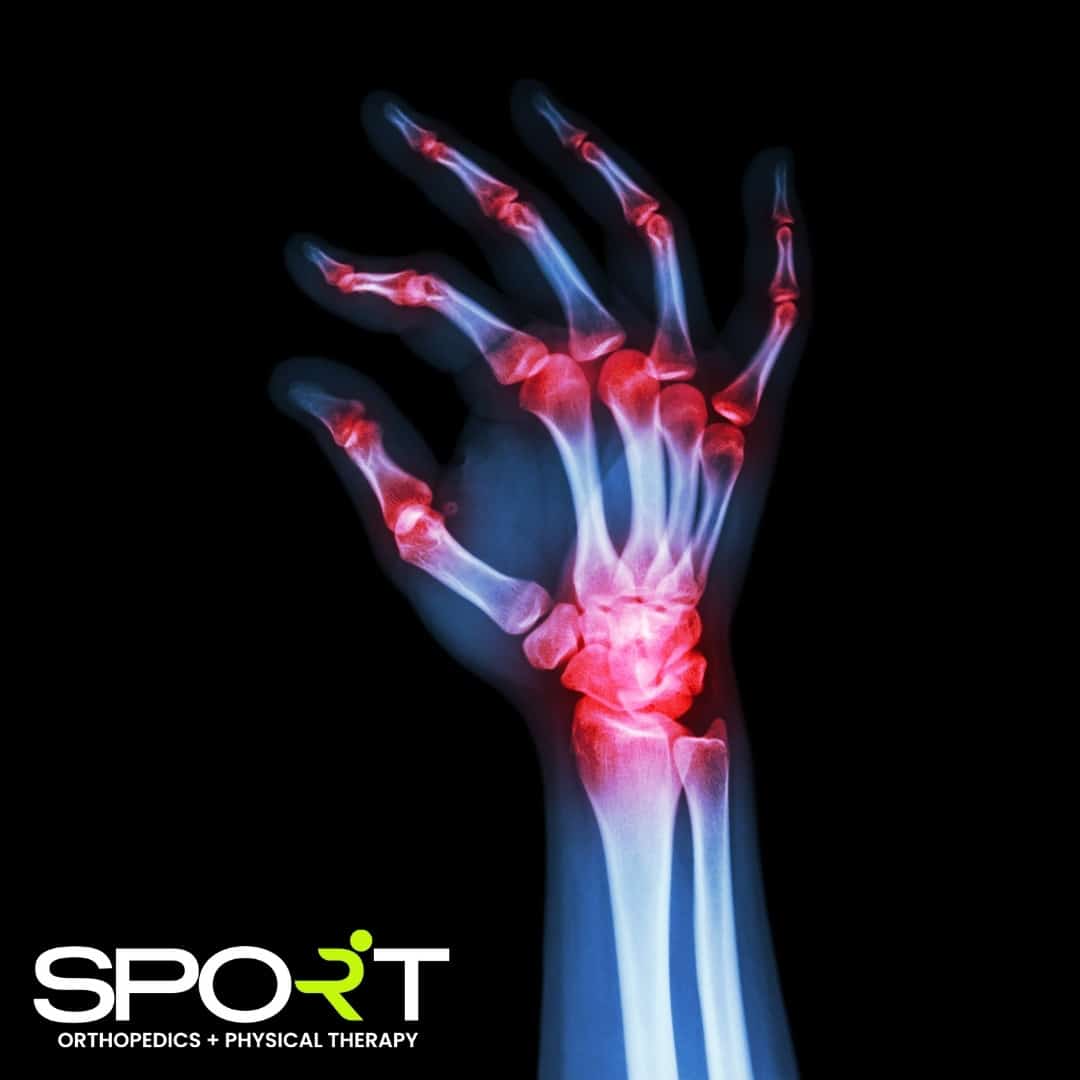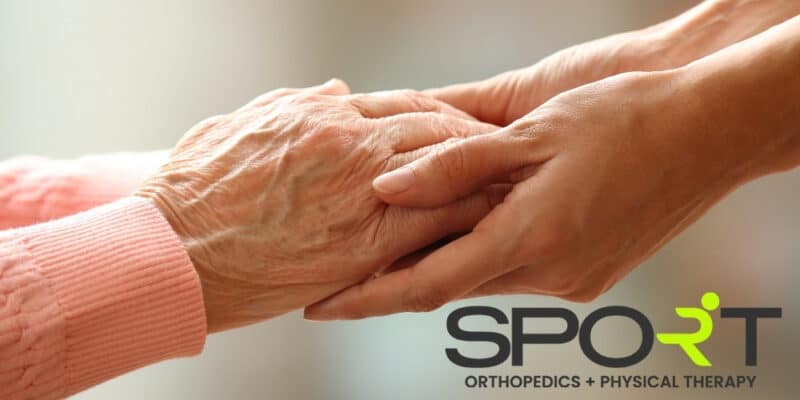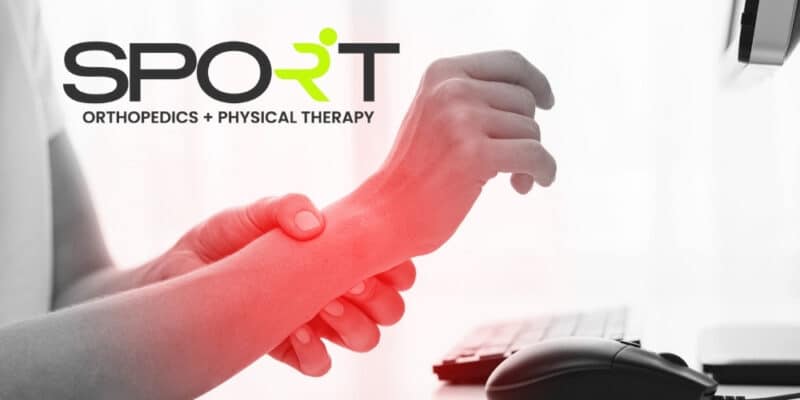Arthritis Treatment in Dallas and Frisco, Texas
Osteoarthritis, Psoriatic Arthritis, Rheumatoid Arthritis
When you think of arthritis, you may think about a grandparent that has flare-ups during bad weather or an elderly neighbor who needs help with daily activities. Over 100 different types of arthritis affect more than 58 million Americans. As the younger generations get older, this number will grow. Arthritis is a chronic disease with no known cure, but the symptoms can be managed with arthritis treatment from experienced professionals.
Our arthritis professionals can get you back to enjoying your daily life without pain. At SPORT Orthopedics and Physical Therapy, our team of professionals can get you back to your life in no time. Schedule an appointment today at (469) 200-2832, or request an appointment online.
What is Arthritis?
Arthritis is a general name for joint inflammation. The prefix “arthr/o” refers to joints, and “-itis” simply means inflammation. Arthritis describes many different diseases that all have the common symptom of swollen, painful joints and connective tissues. Arthritis can cause a decrease in joint function and get worse over time. There is no cure for arthritis, but the symptoms can be treated.
How Do People Get Arthritis?
Anyone can develop arthritis at any age. General wear and tear on your joints can lead to osteoarthritis, while other types are genetic. Lupus and rheumatoid arthritis are autoimmune diseases that can cause immune system attacks on different parts of your body. Risk factors for arthritis can increase your chances of developing a specific type. Women and older people are more likely to develop arthritis. Jobs, injuries, infections, and weight can all mean a higher risk for arthritis. To learn more about the differences between osteoarthritis vs rheumatoid arthritis, read our related blog.

Common Types of Arthritis

The prevailing symptom for all types of arthritis includes pain, swelling, and stiffness around a joint. With more than 100 different types of arthritis, getting a diagnosis often includes ruling out some types. The most common forms of arthritis are osteoarthritis and rheumatoid arthritis. Osteoarthritis develops from wear and tear on your joints. With rheumatoid arthritis, your immune system attacks your joints. Arthritis is linked to other types of conditions, like lupus, gout, and fibromyalgia.
Osteoarthritis
As you age, the cartilage between your joints wears down. This causes a lot of pain and stiffness. Osteoarthritis is the most common form of arthritis. This type of arthritis develops as you age and mostly affects your weight-bearing joints. Your feet, knees, hips, and spine are the joints most likely to suffer. Extra weight around your joints causes more stress and can expedite the process. Injuries and overuse can also cause osteoarthritis. Pain and inflammation in these cases can be controlled by medication, but surgery can also be beneficial.
Rheumatoid Arthritis
Rheumatoid arthritis is an autoimmune disease that makes your immune system attack your joints. Inflammation of the joints can cause joint damage and a severe amount of pain. Many joints are affected at the same time and often happen in a symmetrical pattern. In cases of severe rheumatoid arthritis, medication can be used to slow the progression of the disease. Physicians use blood tests to diagnose rheumatoid arthritis.
Ankylosing Spondylitis
Ankylosing spondylitis is a rare disease that affects the vertebrae in your spine–most often the lower back. With this type of arthritis, the bones in the spine can fuse together. This causes an extreme amount of pain and progresses at a different rate with each person. Many people with AS often develop an eye issue called uveitis, which can cause painful inflammation and a sensitivity to bright light.
Psoriatic Arthritis
Psoriatic arthritis is linked to psoriasis. Psoriasis is a skin disease that causes patches of red, scaly skin. The skin symptoms usually appear first. Only one joint is usually affected, and symptoms can include nail lesions and swollen fingers and toes. Diagnosing psoriatic arthritis is complicated. Your physician may rule out other types of arthritis with blood tests and imaging tests.
Juvenile Idiopathic Arthritis
Children of any age can develop arthritis. When it affects children, arthritis is often called juvenile idiopathic arthritis (JIA) or juvenile rheumatoid arthritis (JRA). Many children have periods of flare-ups and remission. Some children even have permanent remission. Unfortunately, much of the physical damage to the joints is permanent. There is no known cause for childhood arthritis, but it could be due to a misfiring immune system.
Gout
Uric acid crystals can build up in small joints and cause foot pain and inflammation. The joints of the big toe are the ones most often affected, but gout can affect joints in the fingers, elbows, and wrists. A gout attack often lasts anywhere from 3-10 days, and it often resolves on its own. Alcohol, drugs, and stress can trigger an attack. A diet with too much uric acid can also cause a gout attack. Attacks can come and go randomly, but untreated gout can cause attacks that are more frequent and last longer.
Lupus
Like rheumatoid arthritis, lupus is an autoimmune disease. Lupus makes your immune system attack different parts of your body, most often your organs and your joints. There isn’t a known cause for lupus, and diagnosis is difficult. The symptoms of lupus can be attributed to other conditions.
Fibromyalgia
Fibromyalgia is a condition that causes intense pain throughout the body. There is no known cause for fibromyalgia, but people with lupus or rheumatoid arthritis are more likely to develop fibromyalgia. Treatment for fibromyalgia includes physical activity and medication to manage pain.
Arthritis Symptoms

Depending on the specific type of arthritis, the symptoms can vary greatly. Common symptoms can include:
- Recurring joint pain
- Joint stiffness
- Swelling or redness around a joint
- Limited range of motion
The symptoms for each type of arthritis can vary significantly. They may flare up randomly and resolve on their own for a short time before coming back. The symptoms may gradually appear and progressively get worse, or you may wake up one day in immense pain. This is what makes diagnosis for a specific type of arthritis so difficult.
How is Arthritis Diagnosed?
With more than 100 different types of arthritis with slightly differing symptoms, arthritis diagnosis can be difficult. Physicians use a range of lab work, blood tests, X-rays, and questionnaires to diagnose the specific type of arthritis that afflicts you. A blood test for rheumatoid arthritis may be used to diagnose RA, but it can also be used to diagnose another type by ruling out RA. In addition to a physical exam, your doctor will ask about your family history and perform a host of tests to determine the type of arthritis you have. Other types of tests can include biopsies of the skin or muscle and genetic testing. A joint aspiration may be conducted to see if issues like bacteria or uric acid crystals are present.
Arthritis Treatment
Because there is no cure for arthritis, treatments tend to focus on pain relief and preserving physical function. Medical treatments for arthritis include surgical and non-surgical options. No matter which route you choose, you can expect a comprehensive treatment plan from the professionals at SPORT Orthopedics and Physical Therapy.
Surgical
The types of arthritis treated by surgery include osteoarthritis and inflammatory arthritis like rheumatoid arthritis. Many surgical options are available, including joint replacement, arthroscopy, and arthrodesis.
Joint Replacement
A total joint replacement can help severe cases of arthritis. A new joint can help weight-bearing joints function more effectively and without pain. Hip replacements are effective at treating osteoarthritis and painful rheumatoid arthritis. Knee replacements are the most common joint replacements.
Arthroscopy
An arthroscopy involves a tiny incision and an even tinier camera being inserted into the joint. An arthroscopy can allow your surgeon to see the extent of damage to the joint, get biopsies, and smooth rough bones that cause pain. The specialists at SPORT Orthopedics and Physical Therapy can perform arthroscopy on every major joint, including the ankle, knee, hip, wrist, and shoulder.
Arthrodesis
Arthrodesis is a type of fusion surgery where two or more bones are surgically fused. This makes the affected joint lose mobility, but fusion can help the joint bear weight and reduce joint pain.
Osteotomy
Osteotomy is a surgical procedure designed to reshape the bones in the affected joint. This is most often used in osteoarthritis cases. Painful bone spurs can be shaved down, and shaving down other parts of the bone can prevent the damaged area from bearing body weight.
Non-Surgical
Occupational and physical therapy in Dallas can preserve joint function and relieve arthritis pain. Medication can help types of inflammatory arthritis like rheumatoid arthritis. Medication can reduce inflammation in the affected joints.
TENS (transcutaneous electrical nerve stimulation) units can apply electricity to the arthritic joint and numb the nerve endings. Regular massages can increase blood flow around the affected joint and relieve some of the pain and swelling. Yoga can reduce pain and stiffness by stretching the joints and exploring the entire range of motion. There are countless non-surgical options available for arthritis treatment.
Another popular option, particularly for arthritis in the joints, is gel injections. Also called viscosupplements, these injections are extremely effective as a method of pain management. They are also popular as they allow patients to avoid the long and often painful recovery that comes with undergoing surgery.
Arthritis FAQs
Is Arthritis Common?
Over 100 different types of arthritis affect more than 58 million adults in the United States. This is nearly a quarter of the adult population in America.
Who Can Get Arthritis?
Anyone at any age can develop arthritis, but some risk factors increase your risk of developing arthritis. Repeated joint injuries and extra weight can cause osteoarthritis. Smoking can increase your risk of rheumatoid arthritis.
Can Arthritis Be Cured?
To date, there is no cure for arthritis. The symptoms can be treated and managed in a variety of ways, such as physical therapy, medication, and surgery.
Can Arthritis Kill You?
Arthritis is linked to other conditions that can cause death. People with arthritis from autoimmune diseases have a greater risk of suffering complications from other illnesses like the flu. This is due to their weakened immune systems.
Can Arthritis Be Prevented?
Steps you can take to lower your chances of developing arthritis are losing weight/preventing weight gain, avoiding smoking, and keeping limber with regular exercise.
When Does Arthritis Start?
Arthritis symptoms can begin in childhood, but most cases develop during middle age.
If I Think I Have Arthritis, What Should I Do?
If you are suffering from joint pain, contact the specialists at SPORT Orthopedics and Physical Therapy. Our team of experts can help you get back to living your life the way you want.
DFW Arthritis and Joint Pain Treatment
There’s no reason to suffer from joint pain. Arthritis can make doing the most mundane tasks difficult and painful. At SPORT Orthopedics and Physical Therapy, our team of Dallas orthopedic surgeons works to get you back on your feet as quickly and safely as possible. Get some much-needed pain relief by calling us at (469) 200-2832. We know that life doesn’t stop when you have an injury–neither do we! We offer same-day and Saturday appointment options.
If you suffer from shoulder arthritis, knee arthritis, or any other form of arthritis, we’re here for you.


